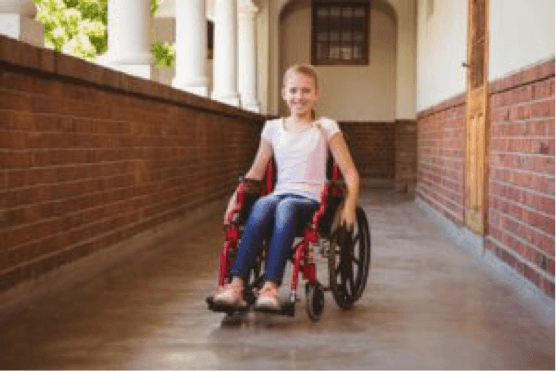K-12 Schools and Universities: Have You Planned for Safe Evacuation of Less Mobile Student and Staff?

As a school or educational institution, you likely have ADA-compliant evacuation procedures set up to protect your less mobile population. You know that you cannot depend on elevators, first responders, or goodwill to transport your non-ambulatory students or staff members to safety. In addition to your pre-existing evacuation procedures, however, a medical evacuation device, such as the Slyde, can ensure your people have the tools and visual cues at hand to help make sure everyone is provided a method of evacuation.
A true crisis can take many forms, yet most schools do not prepare for more than a couple of potential scenarios. In the event of a power outage, violent attack, fire, natural disaster, structural damage, or other emergency situation, any number of obstacles can leave your evacuation plans wanting. By diversifying your options for transporting disabled or unconscious students, you offer more possible solutions and can cover a broader range of contingencies.
The Slyde (formerly called the Paraslyde) is a medical sled that can be operated by two to seven individuals to transport an immobilized person safely down flights of stairs. The Slyde is small, lightweight, and employs a series of web handles and straps to guide a recumbent individual down several flights of stairs. While students and staff who use wheelchairs are the most obvious beneficiaries of a Slyde evacuation device, you may be surprised by who else may have trouble getting down a stairway during an emergency.
Who Else Can Benefit from a Slyde?
In addition to any wheelchair-bound students you are already aware of, there are a number of conditions that may or may not be disclosed on a student or staff member’s official record. Many of these can impact safe and speedy evacuation and may still leave you liable should someone be left behind. For example, temporary conditions both visible (a student with a broken leg) and non-visible (a staff member recovering from a slipped disc or temporarily impaired vision) may leave a less-mobile individual with no way to exit a building. While your permanently disabled or wheelchair-bound students may be well known to you, there is always the possibility that someone may be temporarily using crutches, a cane, a walker, or have other mobility issues that may preclude safe descent of stairs.
Beyond physical limitations, there are other factors that may hinder a person’s ability to function normally during an emergency. Psychological or cognitive conditions, such as PTSD, panic disorders, or autism spectrum disorders easily have the potential to render a person unable to function as expected when a true crisis occurs. Having a device on hand that can safely evacuate any unconscious or nonmobile individuals can help you ensure you are prepared for many scenarios.
Protect Your Students and Staff; Protect Your School
Most schools are familiar with the requirements of the Americans with Disabilities Act, and understand its bearing on state-mandated emergency preparedness and evacuation planning. However, what they may not know is that there have been a series of lawsuits* in recent years in which schools that thought they were prepared were found to be inadequate. Their plans failed to accommodate their disabled students when it mattered. Such schools have had to pay costly settlements for their mistakes.
The most important step you can take to protect your students and staff is to establish an evacuation plan that covers as many potential scenarios as possible. Many schools establish crisis management plans that meet basic state requirements on paper, but leave gaps that leave less-mobile students vulnerable. Adding a Slyde to your facilities can help you make sure you have multiple options and multiple pathways for evacuating disabled or unconscious students.
How to Add the Slyde to Your Evacuation Plan
- Address your students and staff to inform them the device is available for anyone who may not be able to use stairs during an emergency or crisis.
- Keep evacuation Slydes mounted between hallways and stairwells or near elevators.
- Train staff in the safe use of evacuation devices.
- Post “If you need help…” and “How to use the Slyde…” signage at designated points, so anyone can request help and operate the device in a crisis.
- Conduct full contingency drills to rehearse your evacuation plan.
Your present emergency safety procedures may be strong already. But with diverse and constantly changing student populations, the Slyde can help give you reassurance that a safe evacuation (or drill) is always possible. To learn more about the Slyde, visit www.evacuationslyde.com or call us at 800-355-4628.
